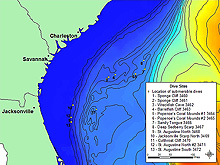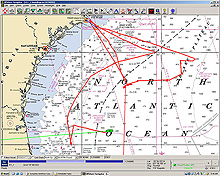
This map displays the 13 dive sites of the Estuary to the Abyss Expedition. Click image for larger view.
Estuary to the Abyss: Exploring Along the Latitude 31-30 Transect
September 1, 2004
George Sedberry
Senior Marine Scientist
South Carolina Department of Natural Resources
With the conclusion of this Ocean Explorer mission, another step has been taken farther offshore and into deeper waters along the "Latitude 31-30 Transect." For more than 20 years, my colleagues aboard the research vessel Seward Johnson and I have been studying the fish and invertebrate faunas of the continental shelf off the southeastern U.S., including those found at 31o30'N latitude. The Estuary to the Abyss Expedition extended our studies down the upper continental slope and onto the Blake Plateau, ending at the "1,000 Meter Curve" at the edge of the abyss.
The fauna of the Blake Plateau is poorly known, because the great depths, rugged bottom topography, and swift Gulf Stream currents and meanders have made it a difficult place to sample. This expedition presented some sampling difficulties as well. We encountered strong currents that made submersible dives difficult, and the depths, currents, and hard, rugged bottom made it difficult to deploy and retrieve gear from the ship. We sometimes brought up an empty catch bag, or lost the gear entirely. During dives on deep cliffs, the submersible would be carried away from the target site, frustrating the scientists intent on observing fishes and invertebrates making their home there. In addition, it is the hurricane season, and we had to run from a few tropical storms and depressions, including Tropical Storm Gaston.
In spite of all that, we made some amazing observations and collections. We explored 300-ft cliffs in depths from 1,200-1,600 ft, and saw even steeper and higher cliffs (400 ft) in depths to 2,800 ft. Shallower cliffs were characterized by numerous caves, crevices, and overhangs that were populated by large wreckfish and red bream. The deeper cliffs had fewer large animals, despite being similar in habitat complexity, as a result of the lower productivity of deeper waters.

The ship track of the research vessel Seward Johnson during the Estuary to the Abyss Expedition. Equipment problems and a family emergency sent the ship to Charleston twice. Tropical Storm Gaston forced the ship south for an impromptu exploration of reefs and scarps east of Jacksonville, Florida. The storm made landfall in Charleston, where all but two of the scientists aboard ship live. Hurricane Frances will ensure that the ship returns on schedule to Ft. Pierce, Florida on Wednesday, September 1. Its predicted track takes it toward Florida by week's end. Click image for larger view.
We observed several animals that have been rarely caught or observed, including the stout beardfish, frilled shark, and Shaefer's anglerfish; we also observed animals that have been frequently collected but infrequently seen in their environment. Each submersible dive provided new records and observations of rare species, and additional information on common species.
Highlights of the sub dives included dives on vertical walls at several depths, dives on deep hard but flat bottoms, and dives on sand ridges and dunes. Often, several different habitats and associated species could be observed on a single dive.
Sub dives gave us a fish's-eye view of the spectacular habitats and organisms of the Blake Plateau, but we also made several observations by deploying sampling gear from the surface ship. We were able to measure temperature, salinity, oxygen content, current velocity, and chlorophyll levels throughout the water column. This enabled us to detect sources of water that flow over the Blake Plateau, and to obtain measures of the biological productivity. We used plankton nets to sample early life history stages of fishes and crustaceans and determine what species might be using the Blake Plateau as a spawning ground. Several crab larvae were caught and kept alive, so that we can observe their growth and describe their growth stages as they molt into juvenile crabs.
From the perspective of a fish biologist, the most exciting observations were those of rare fishes such as Shaefer's anglerfish and the frilled shark. These fishes are very rare in collections, so underwater observations of them are non-existent. It was a fantastic and rare opportunity to observe such rare species. We were also able to collect samples of some of the fishes, including samples of their bacteria and DNA. These samples will enable us to better understand the life history and evolution of these rare species, and some of the effects of human populations on deep-sea organisms.
Returning to port ends the first phase of this exploration. In the coming months we will analyze the videotapes, data from the water-quality measurements, and samples of sediments, rocks, and animals to further our understanding of the diverse and complex habitats of the Latitude 31-30 Transect.
Sign up for the Ocean Explorer E-mail Update List.

























